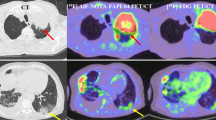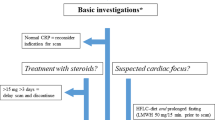Abstract
Background / aim
The use of PET / CT is becoming more common in the elucidation of inflammatory processes in which the underlying cause cannot be determined by conventional examinations. Although PET / CT is an effective method for detecting inflammatory foci, the precise diagnosis may not be obtained in all cases. In addition, considering factors such as radiation exposure and cost, it becomes important to identify patients who can get results with PET / CT. In this study, it was aimed to examine the factors that can predict the differential diagnostic value of PET / CT by retrospectively scanning patients who underwent PET / CT for inflammation of unknown origin (IUO) in rheumatology practice.
Methods
Demographic, clinical and laboratory information of the patients followed up in our clinic and who underwent PET / CT for differential diagnosis were enrolled. Whether they were diagnosed after PET / CT and during the follow - up period, and their diagnoses were examined.
Results
A total of 132 patients were included in the study. A previous diagnosis of rheumatic disease was present in 28.8 % of the patients, and a history of malignancy was present in 2.3 % . The patients were divided into three groups: group 1 patients with increased FDG uptake in PET / CT and diagnosis confirmed by PET / CT, group 2 patients with increased FDG uptake in PET / CT but diagnosis was not confirmed, and group 3 patients without increased FDG uptake in PET / CT. Increased FDG uptake in PET / CT was detected in 73 % of the patients. While PET / CT helped the diagnosis in 47 (35.6 %) patients (group 1), it did not help the diagnosis in 85 (64.4 %) (groups 2 and 3). Thirty - one (65.9 %) of the diagnosed patients were diagnosed with a rheumatologic disease. When the 3 groups were compared, male gender, advanced age, CRP levels, presence of constitutional symptoms, SUVmax values and number of different organs with increased FDG uptake were higher in Group 1. Sixty - six percent and 74 % of the patients in groups 2 and 3 were not diagnosed during the follow - up period. No patient in group 3 was diagnosed with malignancy during follow - up.
Conclusion
PET / CT has high diagnostic value when combined with clinical and laboratory data in the diagnosis of IUO. Our study revealed that various factors can affect the diagnostic value of PET / CT. Similar to the literature, the statistically significant difference in CRP levels shows that patients with high CRP levels are more likely to be diagnosed with an aetiology in PET / CT. Although detection of involvement in PET / CT is not always diagnostic, there was an important finding that no malignancy was detected in the follow - up in any patient without PET / CT involvement.
Key points • PET / CT is an effective method for detecting inflammatory foci. • PET / CT has proven to be effective in the diagnosis of rheumatological diseases, the extent of disease and the evaluation of response to treatment. • Indications for the use of PET / CT in the field of rheumatology and the associated factors and clinical features supporting the diagnosis with PET / CT are still to be fully clarified. • In routine practice, with PET / CT, both delays in diagnosis and examinations performed during diagnosis and the cost can be reduced. |

Similar content being viewed by others

Data Availability
Available upon reasonable request.
References
Schönau V, Vogel K, Englbrecht M, Wacker J, Schmidt D, Manger B et al (2018) The value of 18F - FDG - PET / CT in identifying the cause of fever of unknown origin (FUO) and inflammation of unknown origin (IUO): data from a prospective study. Ann Rheum Dis 77(1):70–77
Vaidyanathan S, Patel C, Scarsbrook A, Chowdhury F (2015) FDG PET / CT in infection and inflammation—current and emerging clinical applications. Clin Radiol 70(7):787–800
Jamar F, Buscombe J, Chiti A, Christian PE, Delbeke D, Donohoe KJ et al (2013) EANM / SNMMI guideline for 18F - FDG use in inflammation and infection. J Nucl Med 54(4):647–658
Kan Y, Wang W, Liu J, Yang J, Wang Z (2019) Contribution of 18F - FDG PET / CT in a case - mix of fever of unknown origin and inflammation of unknown origin: a meta - analysis. Acta Radiol 60(6):716–725
Wenger M, Schirmer M (2022) Indications for diagnostic use of nuclear medicine in rheumatology: a mini - review. Front Med (Lausanne) 9:1026060
Matsui T, Nakata N, Nagai S, Nakatani A, Takahashi M, Momose T et al (2009) Inflammatory cytokines and hypoxia contribute to 18F - FDG uptake by cells involved in pannus formation in rheumatoid arthritis. J Nucl Med 50(6):920–926
Jamar F, van der Laken CJ, Panagiotidis E, Steinz MM, van der Geest KS, Graham RN et al (2023) (eds) Update on imaging of inflammatory arthritis and related disorders. Semin Nucl Med 53(2):287–300
Mandl P, Ciechomska A, Terslev L, Baraliakos X, Conaghan P, D’Agostino MA et al (2019) Implementation and role of modern musculoskeletal imaging in rheumatological practice in member countries of EULAR. RMD Open 5(2):e000950
Slart RH, Signore RB, Sciagrà M, Infection M, Signore I, Members of Committees SCPCWCSD, et al. (2018) FDG - PET / CT (A) imaging in large vessel vasculitis and polymyalgia rheumatica: joint procedural recommendation of the EANM, SNMMI, and the PET Interest Group (PIG), and endorsed by the ASNC. Eur J Nucl Med Mol Imaging 45:1250–69
Dejaco C, Ramiro S, Duftner C, Besson FL, Bley TA, Blockmans D et al (2018) EULAR recommendations for the use of imaging in large vessel vasculitis in clinical practice. Ann Rheum Dis 77(5):636–643
Gholamrezanezhad A, Basques K, Batouli A, Olyaie M, Matcuk G, Alavi A et al (2018) Nononcologic applications of PET / CT and PET / MRI in musculoskeletal, orthopedic, and rheumatologic imaging: general considerations, techniques, and radiopharmaceuticals. J Nucl Med Technol 46(1):33–38
Holubar J, Broner J, Arnaud E, Hallé O, Mura T, Chambert B et al (2022) Diagnostic performance of 18F - FDG - PET / CT in inflammation of unknown origin: a clinical series of 317 patients. J Intern Med 291(6):856–863
Subesinghe M, Bhuva S, Arumalla N, Cope A, D’Cruz D, Subesinghe S (2022) 2 - deoxy - 2 [18F] fluoro - D - glucose positron emission tomography–computed tomography in rheumatological diseases. Rheumatology 61(5):1769–1782
Nienhuis PH, Sandovici M, Glaudemans AW, Slart RH, Brouwer E (2020) (eds) Visual and semiquantitative assessment of cranial artery inflammation with FDG - PET / CT in giant cell arteritis. Semin Arthritis Rheum 50(4):616–623
Gujadhur A, Smith E, McMahon L, Spanger M, Chuen J, Holt SG (2013) Large vessel calcification in T akayasu arteritis. Intern Med J 43(5):584–587
Kraaijvanger R, Janssen Bonás M, Vorselaars AD, Veltkamp M (2020) Biomarkers in the diagnosis and prognosis of sarcoidosis: current use and future prospects. Front Immunol 11:1443
Zhang J, Chen H, Ma Y, Xiao Y, Niu N, Lin W et al (2014) Characterizing IgG4 - related disease with 18 F - FDG PET / CT: a prospective cohort study. Eur J Nucl Med Mol Imaging 41:1624–1634
De Pablo P, Dinnes J, Berhane S, Osman A, Lim Z, Coombe A et al (2022) (eds) Systematic review of imaging tests to predict the development of rheumatoid arthritis in people with unclassified arthritis. Semin Arthritis Rheum 52:151919
Kubota K, Yamashita H, Mimori A (2017) (eds) Clinical value of FDG - PET / CT for the evaluation of rheumatic diseases: rheumatoid arthritis, polymyalgia rheumatica, and relapsing polychondritis. Semin Nucl Med 47(4):408–424
Kubota K, Ito K, Morooka M, Minamimoto R, Miyata Y, Yamashita H et al (2011) FDG PET for rheumatoid arthritis: basic considerations and whole - body PET / CT. Ann N Y Acad Sci 1228(1):29–38
Wakura D, Kotani T, Takeuchi T, Komori T, Yoshida S, Makino S et al (2016) Differentiation between polymyalgia rheumatica (PMR) and elderly - onset rheumatoid arthritis using 18F - fluorodeoxyglucose positron emission tomography / computed tomography: is enthesitis a new pathological lesion in PMR? PLoS One 11(7):e0158509
Takahashi H, Yamashita H, Kubota K, Miyata Y, Okasaki M, Morooka M et al (2015) Differences in fluorodeoxyglucose positron emission tomography / computed tomography findings between elderly onset rheumatoid arthritis and polymyalgia rheumatica. Mod Rheumatol 25(4):546–551
Gholamrezanezhad A, Basques K, Batouli A, Matcuk G, Alavi A, Jadvar H (2018) Clinical nononcologic applications of PET / CT and PET / MRI in musculoskeletal, orthopedic, and rheumatologic imaging. AJR Am J Roentgenol 210(6):W245
Zhou X, Li Y, Wang Q (2020) FDG PET / CT used in identifying adult - onset Still’s disease in connective tissue diseases. Clin Rheumatol 39:2735–2742
An Y - S, Suh C - H, Jung J - Y, Cho H, Kim H - A (2017) The role of 18F - fluorodeoxyglucose positron emission tomography in the assessment of disease activity of adult - onset Still’s disease. Korean J Intern Med 32(6):1082
Wan L, Gao Y, Gu J, Chi H, Wang Z, Hu Q et al (2021) Total metabolic lesion volume of lymph nodes measured by 18 F - FDG PET / CT: a new predictor of macrophage activation syndrome in adult - onset Still’s disease. Arthritis Res Ther 23:1–9
Mabey E, Rutherford A, Galloway J (2018) Differentiating disease flare from infection: a common problem in rheumatology Do 18F - FDG PET / CT scans and novel biomarkers hold the answer? Curr Rheumatol Rep 20:1–4
Balink H, Tan SS, Veeger N, Holleman F, van Eck - Smit B, Bennink R et al (2015) 18 F - FDG PET / CT in inflammation of unknown origin: a cost - effectiveness pilot - study. Eur J Nucl Med Mol Imaging 42:1408–1413
Balink H, Veeger NJ, Bennink RJ, Slart RH, Holleman F, van Eck - Smit BL et al (2015) The predictive value of C - reactive protein and erythrocyte sedimentation rate for 18F - FDG PET / CT outcome in patients with fever and inflammation of unknown origin. Nucl Med Commun 36(6):604–609
Okuyucu K, Alagoz E, Demirbas S, Ince S, Karakas A, Karacalioglu O et al (2018) Evaluation of predictor variables of diagnostic [18F] FDG - PET / CT in fever of unknown origin. QJ Nucl Med Mol Imaging 62(3):313–320
Weitzer F, NazeraniHooshmand T, Pernthaler B, Sorantin E, Aigner RM (2022) Diagnostic value of F - 18 FDG PET / CT in fever or inflammation of unknown origin in a large single - center retrospective study. Sci Rep 12(1):1883
Tsuzuki S, Watanabe A, Iwata M, Toyama H, Terasawa T (2021) Predictors of diagnostic contributions and spontaneous remission of symptoms associated with positron emission tomography with fluorine - 18 - fluorodeoxy glucose combined with computed tomography in classic fever or inflammation of unknown origin: a retrospective study. J Korean Med Sci 36(22):e150
Author information
Authors and Affiliations
Corresponding author
Ethics declarations
Disclosures
None.
Additional information
Publisher's note
Springer Nature remains neutral with regard to jurisdictional claims in published maps and institutional affiliations.
Supplementary information
Below is the link to the electronic supplementary material.
Rights and permissions
Springer Nature or its licensor (e.g. a society or other partner) holds exclusive rights to this article under a publishing agreement with the author(s) or other rightsholder(s); author self-archiving of the accepted manuscript version of this article is solely governed by the terms of such publishing agreement and applicable law.
About this article
Cite this article
Akyüz Dağlı, P., Güven, S.C., Coşkun, N. et al. Rheumatology experience with FDG PET / CT in inflammation of unknown origin: a single - centre report for determining factors associated with diagnostic precision. Clin Rheumatol 42, 2861–2872 (2023). https://doi.org/10.1007/s10067-023-06673-x
Received:
Revised:
Accepted:
Published:
Issue Date:
DOI: https://doi.org/10.1007/s10067-023-06673-x



